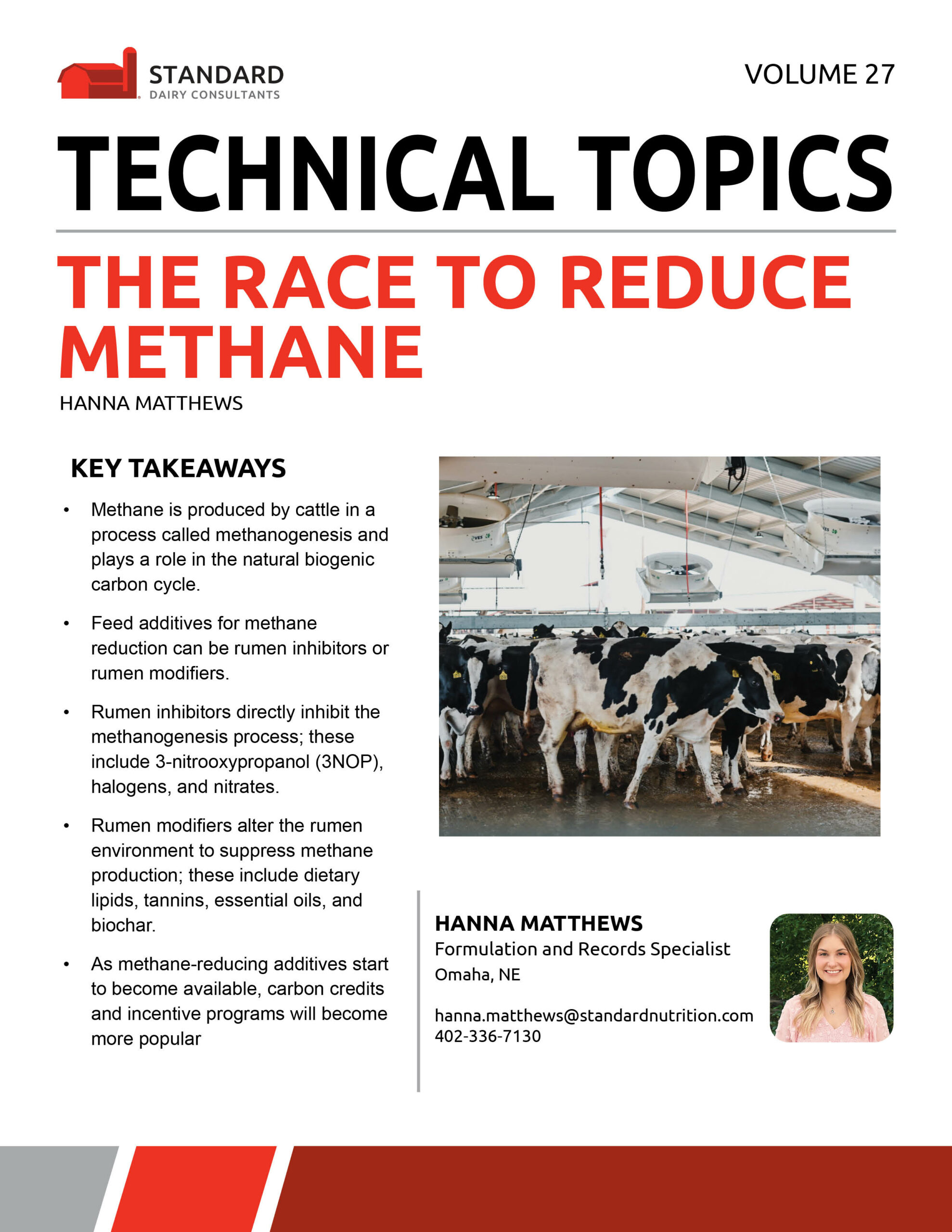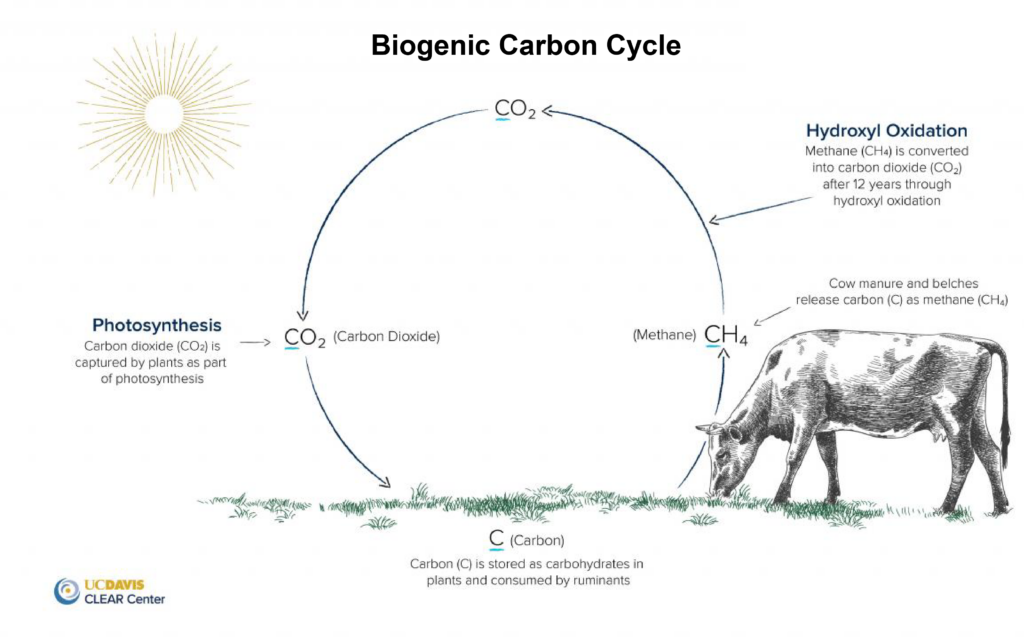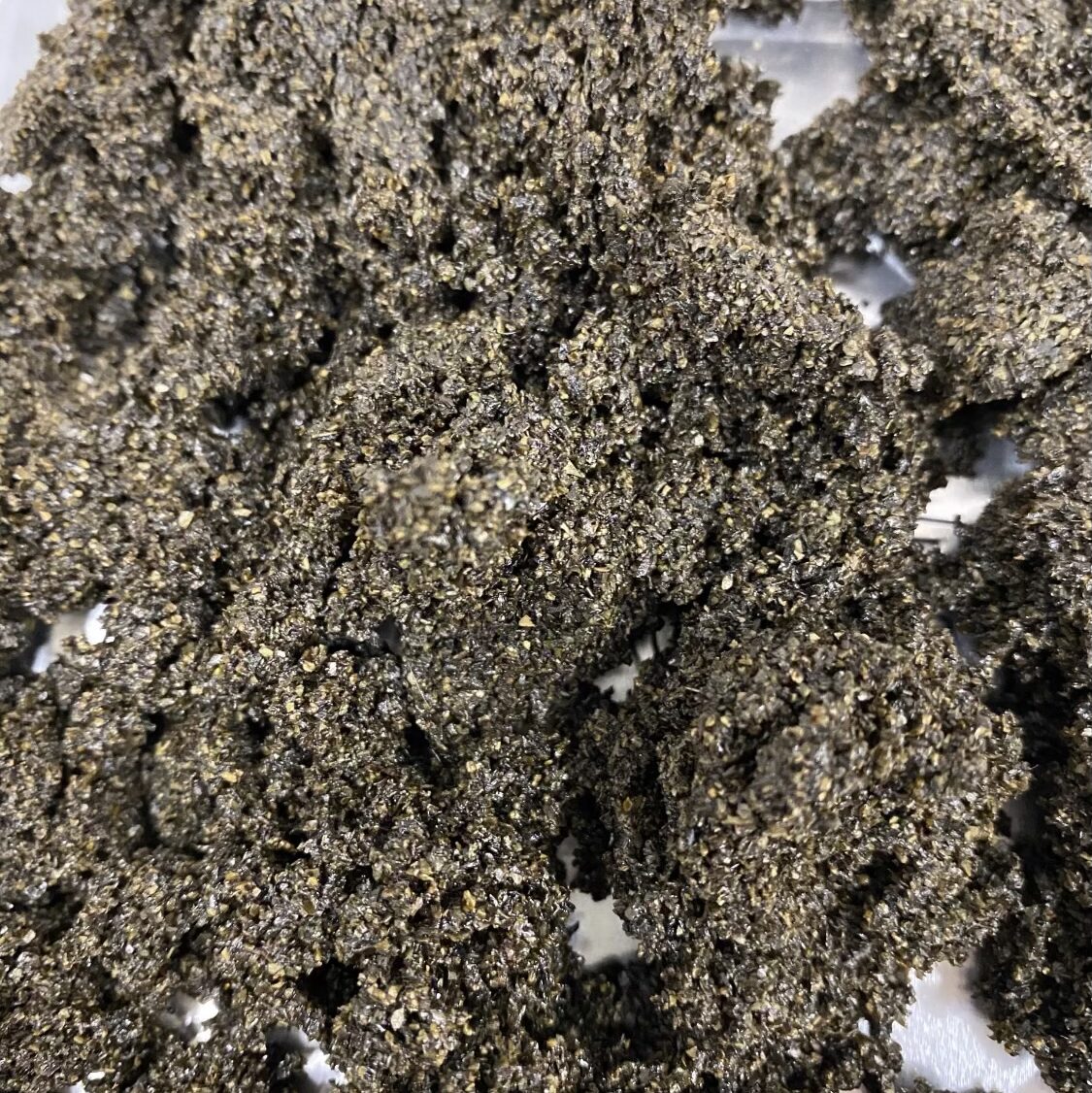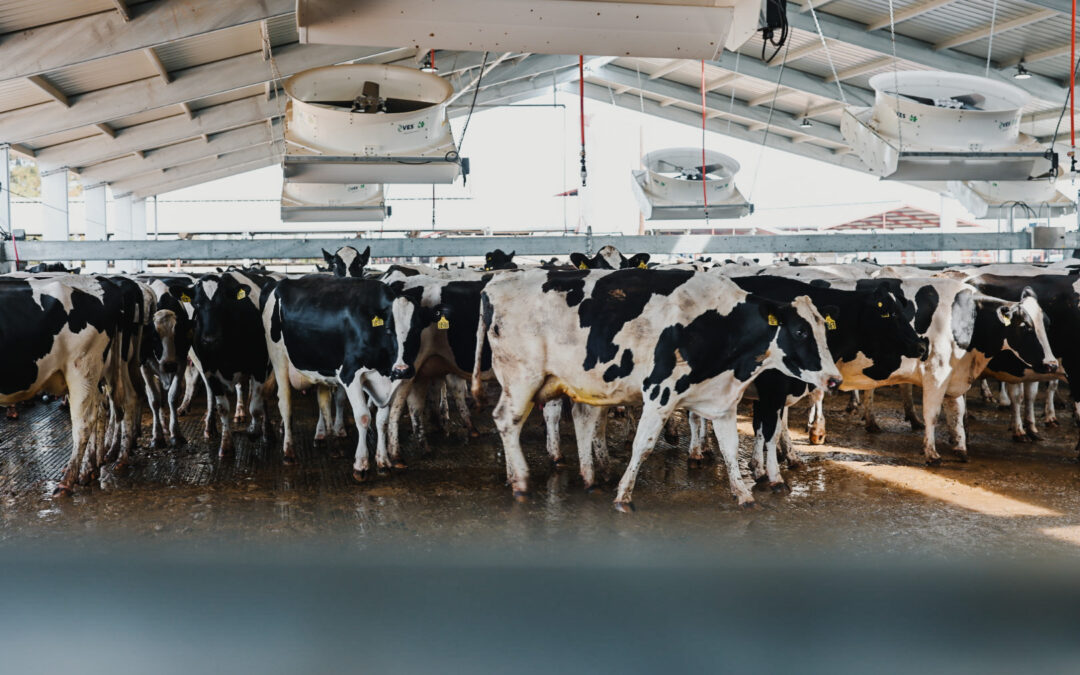Written by: Hanna Matthews
KEY TAKEAWAYS IN THIS ISSUE OF TECHNICAL TOPICS:
- Methane is produced by cattle in a process called methanogenesis and plays a role in the natural biogenic carbon cycle.
- Feed additives for methane reduction can be rumen inhibitors or rumen modifiers.
- Rumen inhibitors directly inhibit the methanogenesis process; these include 3-nitrooxypropanol (3NOP), halogens, and nitrates.
- Rumen modifiers alter the rumen environment to suppress methane production; these include dietary lipids, tannins, essential oils, and biochar.
- As methane-reducing additives start to become available, carbon credits and incentive programs will become more popular

Sustainability and methane emissions are buzzwords when discussing issues surrounding the agriculture industry, mainly when focusing on the cattle industry. We have already seen the first sale of carbon credits, allowing producers to potentially make money by adopting sustainable practices. We will continue to see a rise in the number of programs or products focused on emissions. With the push by consumers and the government to reduce emissions by 2050, how do producers go about making changes without sacrificing production and profits? Many products or methods are being researched and are appearing in an industry that claims to reduce enteric methane emissions. Knowing which products or methods work and which don’t allow us to make the most informed decisions surrounding methane emissions as we attempt to achieve “climate neutrality.”
It is essential to understand the role of methane (CH4) in the ruminant. Cattle produce methane in methanogenesis, where hydrogen (H2) in the rumen has been released and has reduced carbon dioxide (CO2) with the help of methanogenic archaea. This results in methane production and eructation from the ruminant. The production of CH4 by ruminants plays a vital role in the biogenic carbon cycle. This naturally occurring cycle occurs when ruminants consume forage, eruct methane from enteric fermentation into the atmosphere, and then CH4 is reconverted back into CO2 for use by plants in photosynthesis. Methane does have a short lifespan of about 12 years in the atmosphere; however, CH4 does have a global warming potential of about 25x the CO2 equivalent, still making it a contributor to greenhouse gas emissions.
FEED ADDITIVES
While most methane-mitigating additives are not commercially available to producers, some companies have been advertising products that they claim to reduce methane. This will continue as companies roll out carbon credits or incentive programs to feed additives to reduce emissions. These programs will provide payments to producers as an incentive to feed potentially costly additives. We will likely start seeing more and more programs come out incentivizing emissions additives, so it is important to fully understand what you are feeding, what it does in the cow, and how it affects emissions.
Methane mitigators can be broken down into rumen modifiers or rumen inhibitors. Rumen inhibitors directly act on the methanogenesis process to reduce methane production. Some of the most common rumen inhibitors discussed are 3-nitrooxypropanol (3NOP), halogens, and nitrates. A rumen modifier works by changing the rumen environment to limit the growth of methanogens or to suppress methane production. The most common rumen inhibitors are dietary lipids, tannins, essential oils, and biochar.

3-NITROOXYPROPANOL
3NOP works to inhibit a key enzyme in the methanogenesis process. Studies done in dairy and beef cattle have shown promising effects of 3NOP. These studies have shown a 15-30% reduction in CH4 production in lactating dairy cattle. Similar results have been seen in beef cattle. 3NOP does not seem to impact growth, performance, or production in beef or dairy cattle. It has been shown to increase milk fat content in dairy cattle and improve feed efficiency in beef cattle. Recently, 3NOP additives have been approved by the FDA to feed to lactating dairy cattle. This is the first of the kind in the methane feed additives to have FDA approval and ushers in the ability to use additives to reduce methane while creating a new revenue stream (through the carbon credit market) for the dairy.

HALOGENS
Halogenic compounds are found in many plants and can interfere with a key enzyme in methanogenesis. Bromoform is a common halogen that has been researched for its ability to reduce methane. Found most effectively in a seaweed species called Asparagopis taxiformis, this compound has been shown to reduce methane anywhere from 39-98% in beef and dairy cattle. However, high levels of bromoform can impact the dry matter intake of the animals, likely due to the slightly “fishy” smell of the seaweed. Bromoform is a known carcinogen and has been reported to impact the ozone layer negatively; however, bromoform has been shown to be undetectable in the meat and milk of animals fed the seaweed. Due to these concerns about bromoform, A. taxiformis is not yet available commercially for methane reduction.
NITRATES
Nitrates in the diet can also reduce methane emissions from cattle by acting as an alternative hydrogen sink in the rumen. Research has shown a reduction in methane emissions of up to 16% when supplementing nitrates to cattle. Feeding excess nitrates for methane suppression can come at a cost to the animal. Nitrate toxicity can result in blood not being able to carry oxygen properly, which can cause the death of animals. This is of particular concern in areas where groundwater may already be high in nitrate concentration. The potential for nitrate toxicity overshadows the potential methane reduction, so this method is not recommended.
DIETARY LIPIDS
Dietary lipids can be utilized to reduce enteric methane by being toxic to the rumen methanogens, hydrogenating unsaturated fatty acids, and shifting VFA production to favor propionate. However, the efficacy of dietary lipids in reducing enteric methane is variable. Research has reported a reduction in enteric methane of 3-9%. In addition to the varying results, fatty acid supplementation can decrease dry matter intake, milk yield, and milk fat. While supplementing lipids can show a decrease in enteric methane emissions, it can also have a significant impact on the animal’s productivity.
TANNINS
Tannins naturally occur in many plant tissues as a form of plant defense; however, how they can mitigate methane emissions is unclear. It is believed that tannins play some role in mitigating by reducing fiber digestibility or inhibiting methanogens. High levels of tannins (up to 151 g/kg of dry matter) can reduce methane emissions by 54%; however, this high level of tannins can decrease dry matter digestibility and decrease VFA concentrations. Tannins must be fed with a carefully formulated diet so that the animal does not become sensitive to the high levels of tannins fed.
ESSENTIAL OILS
Essential oils, much like tannins, are naturally occurring substances that give color or scent to plants. In the rumen, essential oils can affect rumen microbial communities. However, due to the non-specificity of essential oils in the rumen, they can also impact beneficial microbial populations. Oregano is one of the essential oils that has been researched for its potential benefits in reducing enteric methane. While some studies found up to a 40% reduction in methane, others have not found any methane reduction. Garlic and cinnamon oil are also common essential oils believed to have anti-methanogenic properties; however, no research has backed up the reduction of methane when these compounds are added. While considered safe for the animal, essential oils are variable in their ability to reduce methane. While essential oils have been seen to have very limited success in reducing enteric methane, some essential oil blends have been shown to reduce enteric methane. Agolin® Ruminant is a blend of eugenol and coriander essential oil that has been shown to reduce methane by 6% per cow per day and up to 20% less methane produced per kilogram of milk in dairy cattle. However, in a different research study, no methane reductions were found when Agolin® Ruminant contained lauric acid.
The essential oils contained in the blend seem to impact the effectiveness of methane reduction. Mootral is an essential oil blend containing garlic and citrus extracts made in Europe that works to target methanogenic archaea. When fed to lactating dairy cattle, Mootral reduced 20.7-38.3% with a slight increase in milk yield. This is a promising result of feeding Mootral, but further research is needed to find a consistent dosage of Mootral. Essential oil blends show more promise in reducing enteric methane than when fed alone; however, much like other additives, there is no approval to feed essential oil blends to reduce methane.
BIOCHAR
Biochar is made from cellulose-rich organic matter that has undergone pyrolysis or gasification, or the heating of the materials (< 800 degrees Celsius) in low oxygen conditions. Biochar can be produced from wood, nut shells, rice husks, and other agricultural or forestry wastes. Various biochars can differ based on the method of making them and the size of the granules. The role of biochar in the reduction of enteric methane is unclear; however, some hypothesize that biochar can help to promote a greater rate of methanotrophs, which can oxidize methane. Biochar use to reduce enteric methane has shown conflicting results. Some research has shown that biochar can reduce methane anywhere from 9.5%-24%, depending on the amount supplemented in the diet. However, other research has shown no impact on methane or a slight increase in enteric. Biochar is not yet commercially available to the public.

With the push to be climate-neutral by 2050, the cattle industry must adopt new practices to achieve this. While we only have approval for a single methane-reducing feed additive, carbon credits and incentive programs are starting to roll out to producers. Knowing some of the research behind these additives can help producers and allied industries understand what these programs offer.


